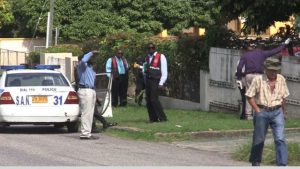 The Planning Institute of Jamaica (PIOJ) has reported a 2.4 per cent increase in Jamaica’s murder rate for the first six months of the year, when compared to the corresponding period in 2015.
The Planning Institute of Jamaica (PIOJ) has reported a 2.4 per cent increase in Jamaica’s murder rate for the first six months of the year, when compared to the corresponding period in 2015.
Outside of murder, the country, however, had a 22.8 per cent decline in category one crimes which are sub-divided into two groups – serious and violent crimes and acquisitory crimes – in keeping with the classifications of the Jamaica Constabulary Force.
Category one crimes include murder, shooting, rape, aggravated assault, robbery, break-ins and larceny.
Speaking at the PIOJ’s quarterly media briefing at the institute’s New Kingston head office yesterday, Deputy Director General Richard Lumsden, in presenting an update on Vision 2030 Jamaica, noted that a total of 117 category one crimes per 100,000 population were committed between January and June 2016, showing a decline of 22.8 per cent from 151 per 100,000 population over the similar period in 2015.
The murder rate, however, during the period increased with 22.2 murders per 100,000 population being committed, up 2.4 per cent, over the similar period in 2015,” Lumsden said.
“These figures continue the downward trend in overall crime rates that began in June of 2010 into a sixth consecutive year, despite the upward movement in the murder rate in the first half of 2016,” the deputy director continued.
The PIOJ also reported on key indicators of national well-being in two main reporting areas — Labour Force Quality and Security Status — under the Vision 2030 Jamaica National Development Plan.
According to Lumsden, there was an improvement in the quality of the country’s labour force with 25.4 per cent of the total labour force now having vocational or professional certification, based on the quarterly labour force survey for April 2016. This is an increase of 0.6 percentage point from 24.8 per cent in the April 2015 survey.
The total labour force for April 2016 increased by 53,100 people to 1,353,500, compared with April 2015 when teh addition of 40,100 new jobs pushed the labour force to 1,168,600.
However, with more people looking jobs after graduating from school, the unemployment rate saw a slight movement of 0.5 percentage points to 13.7 per cent, compared with 13.2 per cent in April 2015.
Newly appointed director general of the PIOJ, Wayne Henry, attributed the increase in unemployment to an increase in the number of people seeking work, compared to available jobs.
He said there was a decline in the number of people who were at school part-time, while there was an increase in confidence as some who were not actively seeking work now believe they can find jobs.
